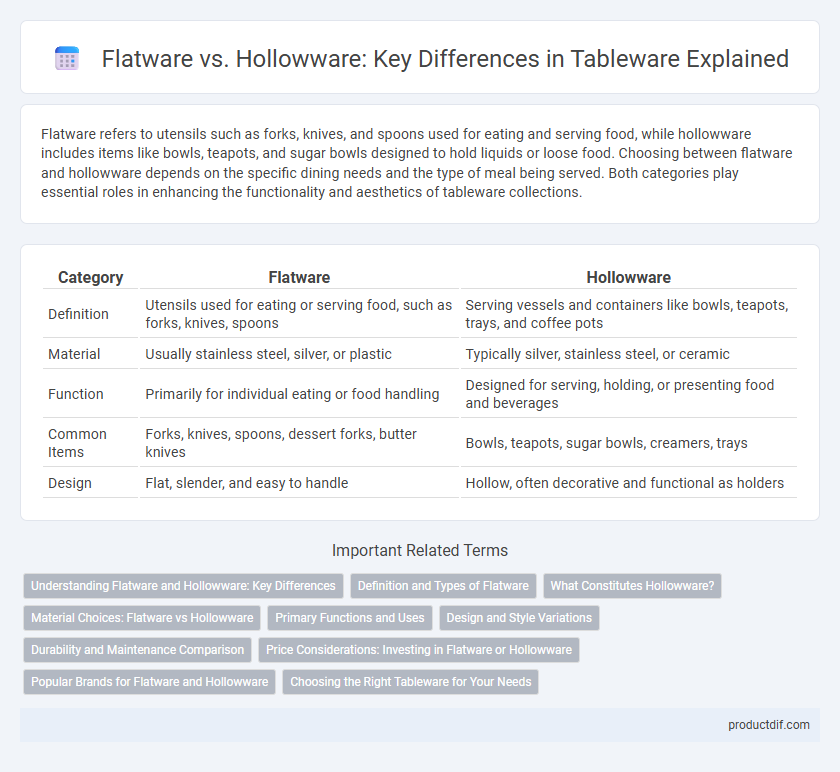Flatware refers to utensils such as forks, knives, and spoons used for eating and serving food, while hollowware includes items like bowls, teapots, and sugar bowls designed to hold liquids or loose food. Choosing between flatware and hollowware depends on the specific dining needs and the type of meal being served. Both categories play essential roles in enhancing the functionality and aesthetics of tableware collections.
Table of Comparison
| Category | Flatware | Hollowware |
|---|---|---|
| Definition | Utensils used for eating or serving food, such as forks, knives, spoons | Serving vessels and containers like bowls, teapots, trays, and coffee pots |
| Material | Usually stainless steel, silver, or plastic | Typically silver, stainless steel, or ceramic |
| Function | Primarily for individual eating or food handling | Designed for serving, holding, or presenting food and beverages |
| Common Items | Forks, knives, spoons, dessert forks, butter knives | Bowls, teapots, sugar bowls, creamers, trays |
| Design | Flat, slender, and easy to handle | Hollow, often decorative and functional as holders |
Understanding Flatware and Hollowware: Key Differences
Flatware refers to utensils used for eating and serving food, including knives, forks, and spoons, typically crafted from stainless steel or silver. Hollowware encompasses items such as teapots, bowls, and trays, distinguished by their hollow form and primarily designed for serving or holding food and beverages. Understanding the key differences involves recognizing flatware as individual eating tools, whereas hollowware consists of larger, vessel-like pieces used in food presentation.
Definition and Types of Flatware
Flatware refers to utensils used for eating and serving food, including forks, knives, and spoons, which are typically made from stainless steel, silver, or plastic. Hollowware encompasses items such as bowls, teapots, pitchers, and serving dishes designed to hold food or liquids. Types of flatware include dinner forks, salad forks, steak knives, soup spoons, and dessert spoons, each tailored for specific dining purposes and often classified by size and function.
What Constitutes Hollowware?
Hollowware refers to tableware items made from metal that have a hollow interior, such as teapots, pitchers, bowls, and sugar bowls, distinguished from flatware which includes utensils like forks, knives, and spoons. These hollow items serve functional purposes in serving and beverage presentation, often crafted from silver, stainless steel, or pewter for durability and aesthetic appeal. Collectors and enthusiasts value hollowware for its craftsmanship and historical significance in dining traditions.
Material Choices: Flatware vs Hollowware
Flatware is commonly made from stainless steel, silver, or titanium, chosen for durability and resistance to corrosion, while hollowware often utilizes sterling silver, silver-plated metals, or fine china for an elegant presentation. Stainless steel flatware offers practical everyday use with easy maintenance, whereas hollowware materials prioritize aesthetic appeal and craftsmanship, often featuring intricate designs and finishes. The material choice directly affects the item's weight, longevity, and suitability for formal dining or casual settings.
Primary Functions and Uses
Flatware primarily includes utensils such as forks, knives, and spoons, designed for eating and serving food directly at the table. Hollowware consists of hollow vessels like teapots, sugar bowls, and creamers, meant for holding, serving, or storing liquids and other items. Understanding the distinction between flatware's functional role in food consumption and hollowware's purpose in food and beverage presentation enhances the organization and utility of table settings.
Design and Style Variations
Flatware and hollowware exhibit distinct design and style variations that cater to different dining needs and aesthetic preferences. Flatware, primarily consisting of forks, knives, and spoons, showcases sleek, ergonomic designs with a focus on balance and comfort, often featuring polished stainless steel, matte finishes, or intricate engravings for added elegance. Hollowware, including items like teapots, sugar bowls, and serving trays, tends to highlight more elaborate craftsmanship and decorative elements such as embossed patterns, ornate handles, and vintage-inspired motifs, blending functionality with artistic appeal.
Durability and Maintenance Comparison
Flatware, typically made from stainless steel or silver-plated materials, offers superior durability and resistance to everyday wear, making it ideal for frequent use. Hollowware, often crafted from sterling silver or silverplate, requires more careful maintenance to prevent tarnishing and dents, impacting its long-term durability. Choosing between flatware and hollowware depends on balancing the need for robust, low-maintenance utensils with the desire for elegant serving pieces that demand more upkeep.
Price Considerations: Investing in Flatware or Hollowware
Flatware often presents a more budget-friendly option compared to hollowware, with prices varying based on material quality and brand reputation. Investing in stainless steel flatware ensures durability and affordability, while sterling silver hollowware commands higher prices due to craftsmanship and precious metal content. Buyers should weigh the long-term value and usage frequency when allocating budget to either flatware or hollowware collections.
Popular Brands for Flatware and Hollowware
Popular brands for flatware include Oneida, known for durable stainless steel sets, and Lenox, offering elegant designs with a focus on quality craftsmanship. Hollowware brands such as Christofle and Reed & Barton specialize in silver-plated serving pieces and decorative items, appealing to collectors and those seeking luxury table accessories. Both categories emphasize premium materials and design innovation to meet diverse dining and entertaining needs.
Choosing the Right Tableware for Your Needs
Selecting the appropriate tableware involves understanding the distinction between flatware and hollowware to match your dining style. Flatware includes utensils like forks, knives, and spoons essential for everyday meals, while hollowware encompasses items such as bowls, teapots, and serving dishes designed for serving and presentation. Choosing tableware tailored to your needs enhances functionality and elevates the dining experience, with considerations for material, design, and occasion guiding optimal selections.
Flatware vs Hollowware Infographic

 productdif.com
productdif.com